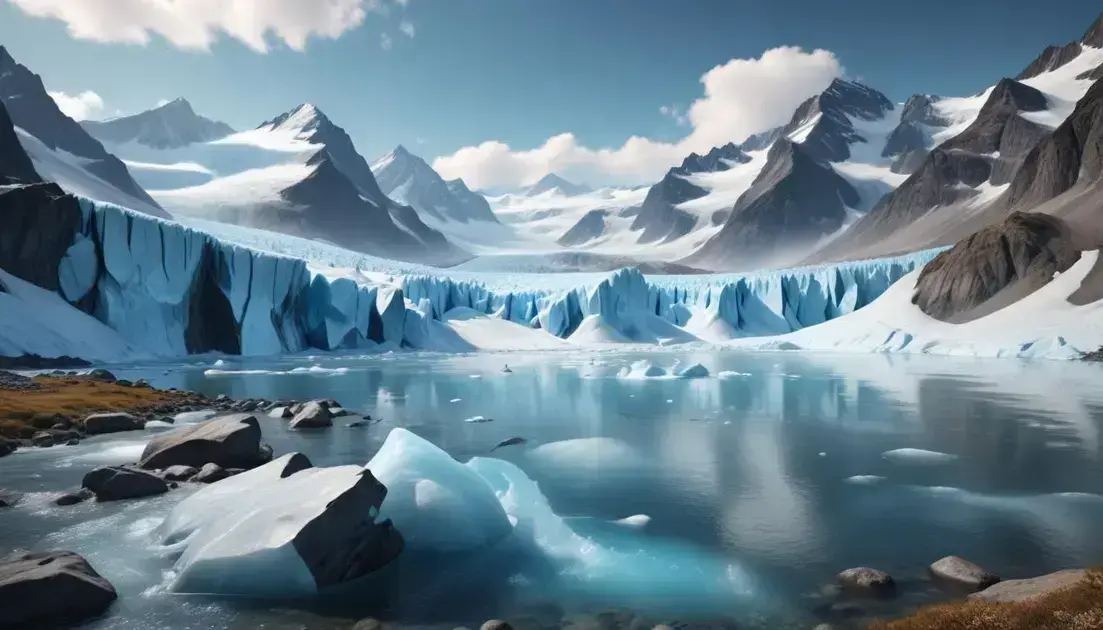How Glacier Preservation Impacts Climate Change
Glacier preservation is essential for maintaining freshwater supplies, protecting ecosystems, and combating the adverse effects of climate change, as melting glaciers lead to water scarcity and biodiversity loss.
Throughout the world, glacier preservation is becoming increasingly critical as we face the urgent repercussions of climate change. Have you ever wondered how the melting of these icy giants affects our daily lives?
The role of glaciers in the water cycle
The role of glaciers in the water cycle is crucial for maintaining ecosystem balance. Glaciers store a significant amount of fresh water, acting as natural reservoirs that release water gradually throughout the year. This gradual melting ensures that rivers and lakes maintain their flow even during dry seasons.
As glaciers melt due to rising temperatures, the dynamics of the water cycle change. The increase in fresh water from this melt can temporarily boost river flows, but the long-term implications often lead to water scarcity. Regions that rely on glacial meltwater for irrigation and drinking water face serious challenges as glaciers retreat.
The loss of glaciers not only affects water availability but also impacts wildlife that depend on cold water habitats. Species such as salmon rely on specific water temperatures and flow rates to thrive. As glaciers diminish, their habitats become altered, disrupting entire ecosystems.
Moreover, the interaction of glacial melt with ocean waters contributes to sea level rise, posing a threat to coastal communities. Understanding the interconnectedness of glaciers and the water cycle is vital for addressing water resource management, ecosystem health, and climate adaptation strategies.
Consequences of glacier melt on ecosystems
The consequences of glacier melt on ecosystems are profound and multifaceted. As glaciers recede, they alter habitats and the availability of fresh water for myriad species. This can lead to shifts in local biodiversity as animals and plants struggle to adapt to changing conditions.
As glaciers melt, the increased freshwater influx into rivers can temporarily boost the quantity of water available. However, this is often followed by long-term decreases in water supply, impacting species that rely on consistent flow levels, such as fish and amphibians. Disruption of these water systems can lead to reduced populations and even extinctions.
Furthermore, melting glaciers can change water temperatures and chemistry, which affects aquatic life. For instance, the increase in sediment and nutrient runoff can lead to algal blooms, which deplete oxygen levels and harm fish. The delicate balance of these ecosystems is at risk as temperatures rise.
Additionally, many indigenous communities depend on glacial melt for their livelihoods. As glaciers diminish, these communities face significant challenges in securing clean drinking water, agriculture, and fishing. Understanding the intricate relationships between glacier melt and ecosystems is crucial for developing effective conservation strategies.
Strategies for glacier preservation initiatives
Strategies for glacier preservation are increasingly vital as climate change accelerates the melting of these critical natural resources. One effective approach is the establishment of protected areas where glaciered regions are monitored and preserved. These conservation efforts help maintain the ecosystem balance while promoting biodiversity.
Engaging local communities in glacier conservation is another important strategy. By partnering with indigenous populations, initiatives can leverage traditional knowledge and cultural practices that align with environmental stewardship. This collaboration fosters a sense of ownership, encouraging sustainable practices.
Additionally, advocating for policies that mitigate climate change is essential. These can include regulations aimed at reducing greenhouse gas emissions and promoting renewable energy sources. By addressing the root causes of climate change, we can slow the rate of glacier melt.
Engagement in scientific research also plays a crucial role. Funding studies on glacier dynamics can enhance understanding of their significance within the broader climate system. This information aids in developing more informed conservation strategies. Public education efforts about the importance of glaciers can also raise awareness and support for preservation initiatives.
Impact of climate change on water scarcity
The impact of climate change on water scarcity is a pressing issue affecting millions globally. As temperatures rise, patterns of rainfall and snowfall are changing, leading to altered water distribution. This shift results in regions experiencing droughts while others face flooding, creating a disbalance in water availability.
In many areas, glacial melt—once a reliable source of freshwater—is decreasing due to warmer climates. This reduction threatens communities dependent on glacial rivers for drinking water and agriculture. Without adequate water supplies, crop yields decline, leading to food insecurity.
In addition to changes in water supply, climate change affects water quality. Increased temperatures can lead to algal blooms, which contaminate drinking sources. These blooms can produce toxins harmful to both humans and aquatic life, further complicating water access and safety.
Furthermore, rising sea levels result in saltwater intrusion into freshwater aquifers, particularly in coastal regions. This phenomenon degrades freshwater supplies, making them unsuitable for drinking or irrigation. Understanding the multifaceted impacts of climate change on water scarcity is crucial for developing adaptive management strategies to ensure water availability for future generations.
In summary, the importance of glacier preservation
As we have seen, the preservation of glaciers is crucial for maintaining environmental balance and ensuring water availability for countless communities and species. Changes in climate directly influence these majestic ice structures, leading to severe consequences for ecosystems worldwide.
By implementing effective strategies for glacier conservation, promoting public awareness, and engaging local communities, we can work towards a sustainable future. The interconnectedness of glaciers with the water cycle highlights the urgent need for action against climate change.
Protecting our glaciers is not only about conserving ice; it’s a fight for our water resources and, ultimately, for the health of our planet. Together, we must strive to safeguard these vital resources for future generations.
People also ask
Why is glacier preservation important?
Glacier preservation is vital for maintaining freshwater supplies and supporting ecosystems that depend on these water sources.
How does climate change affect glaciers?
Climate change causes glaciers to melt at an accelerated rate, leading to rising sea levels and reduced water availability for communities.
What are the consequences of glacier melt on ecosystems?
The melting of glaciers can disrupt habitats, decrease biodiversity, and affect species that rely on cold water environments.
What strategies can be employed for glacier preservation?
Effective strategies include creating protected areas, engaging local communities, promoting renewable energy, and funding scientific research.
How can individuals contribute to glacier preservation efforts?
Individuals can raise awareness about climate change, support conservation initiatives, and reduce their carbon footprint through sustainable practices.
What role do glaciers play in the water cycle?
Glaciers act as natural water reservoirs, slowly releasing freshwater that sustains rivers and ecosystems during dry periods.





